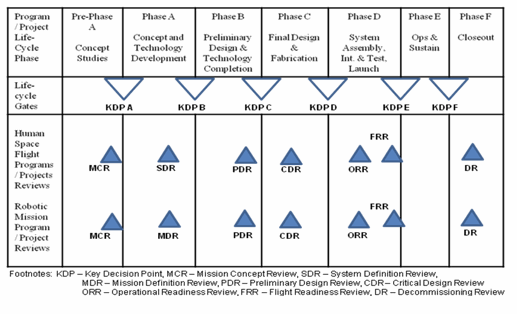Chapter 3. PRA Scope and Level of Detail
3.1 Overview
3.1.1 The purpose of a PRA is to provide risk information for decision making during various phases of a program/project life cycle. Risk information is used as input for decisions involving concept, architecture and mission formulation, functional and hardware design after including humans and software, and mission operations. These types of decisions occur during program/project development studies, preliminary and detail design activities, and mission profile studies to support internal and external technical reviews. Specifically, a PRA is developed as part of these activities to help identify alternatives that pose the least risk within program/project constraints and to provide risk information to support program/project technical reviews.
3.1.2 While all program/project life-cycle phases can be supported by a PRA, the best use of the PRA is to support the life-cycle phase activities leading up to System Definition Review/Mission Definition Review (SDR/MDR), Critical Design Review (CDR), Operational Readiness Review/Flight Readiness Review (ORR/FRR), and mission operations where important conceptual, architectural, design, and operational decisions are being made. The program/project life-cycle phase and technical reviews supported by a PRA are illustrated in Figure 2. The type of decisions made during each life-cycle phase varies dependent on the type of program/project (human space flight, robotic, infrastructure, or other) being conducted.

Figure 2. Key Decision Points and Technical Reviews Supported by PRA
3.1.3 PRAs are conducted to support design, safety, health, and performance decisions as the program/project progresses through its life-cycle phases. The scope, level of detail, and rigor of the PRA are commensurate with the program/project life-cycle phase activity being assessed along with program/project complexity and the severity of the hazards and potential consequences (e.g., human safety and health, mission success, strategic importance).
3.1.4 Additionally, PRA also supports outside stakeholder requirements such as the safety analyses conducted for space nuclear missions (see NSC/PD-25, Scientific or Technological Experiments with Large-Scale Adverse Environmental Effects and Launch of Nuclear Systems into Space).
3.2 Program Life-Cycle Phases
3.2.1 During the life-cycle of a program/project, risk assessments and risk information can be used to support specific phase activities and decisions and as input to the following technical reviews and phases: SDR/MDR, CDR, and ORR/FRR, and Phase E, Operations and Sustainment. The types of decisions that occur prior to and during these life-cycle phases involve:
a. Mission architecture, proposed system architecture and design, definition of functional and performance requirements, and the flow down of functional elements of the mission to ensure that the overall concept is complete and feasible.
b. Detailed design based on a demonstration that the preliminary design meets all system requirements with acceptable risk. Inputs to these decisions involve the selection of design options, the identification of interfaces, and the description of verification methods.
c. Completion of flight and ground system development and mission operations, meeting mission performance requirements, and authorizing operations (launch, flight, space, or infrastructure) based on system technical maturity, documentation, test data, and analyses that support verification.
3.2.2 A well designed PRA is structured and developed incrementally to be suited to "grow" though the life-cycle phases involving these activities. Detailed discussions of program/project life-cycle phases and technical reviews are given in NPD 7120.4, NPR 7120.5, NPR 7123.1, and the NASA/SP-2007-6105.
3.3 Application of PRA to Support Decisions
3.3.1 For each program/project life-cycle phase, the PRA lead, in coordination with the PRA team, reviews the decisions that need to be made. Based on the type of program/project (crewed space flight, robotic, nuclear, infrastructure), the specific objectives, input from the program/project manager, and the program/project maturity, the PRA lead and PRA team define the scope and level of detail of the PRA. The PRA addresses technical, mission success, and safety and health risk. It does not address programmatic risk involving the consideration of cost and schedule.
Note: Comments on the development of the scope and level of detail of the PRA are given in Appendix C. A discussion of cost risk assessment is given in the NASA Cost Estimating Handbook (2008).
3.3.2 The PRA lead shall:
a. Document the plans (level, scope, and approach) for implementing and conducting the PRA in a program/project risk management plan or other planning documentation (e.g., PRA plan, program plan, reliability and maintainability plan).
b. Ensure that the PRA plan is approved by the program/project manager and has concurrence from the Center SMA Director prior to conducting the PRA (see Section 4.6.1.c).
DISTRIBUTION:
NODIS
This Document is Obsolete and Is No Longer Used.
Check the NODIS Library to access the current version:
http://nodis3.gsfc.nasa.gov
![[NASA Logo]](../Images/nasaball.gif)
